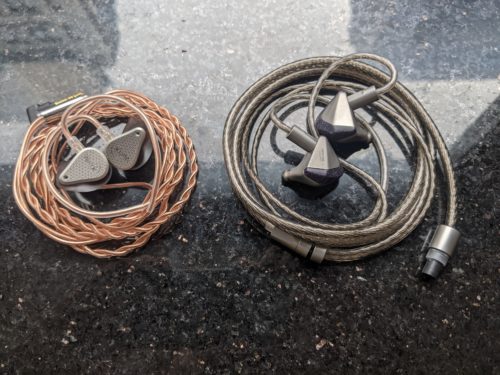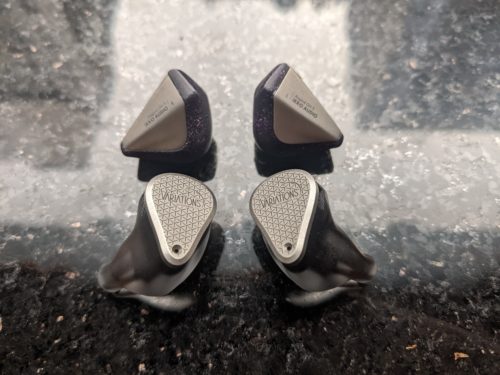Ikko Asgard OH5 vs. Moondrop Variations Comparison Review
In my video review of the iKKO Asgard OH5, one question was repeated in the comments more than any other: “How does this compare to the Moondrop Variations?” Both are semi-niche yet well-anticipated IEM releases with frequency response profiles that, when compared, strike a curious balance of differences and similarities. With the Asgard OH5 priced at $489 and the Variations at $520, they do, in fact, seem ripe for comparison. I’ll be going over the differences in their similarly impressive technical designs, how they fit, and lastly, what you’re probably actually here for: how they sound.

What’s In The Box?
Moondrop Variations:
-3 pairs Silicone Ear Tips (S/M/L)
-3 Pairs Foam Ear Tips (S/M/L)
-Spare Filters and Tweezers
-2 Pin Cable
-2.5mm, 3.5mm, and 4.4mm adapters
-Firm Carrying Case
iKKO Asgard OH5
-3 Pairs Circular Foam Ear Tips (S/M/L)
-3 Pairs Ovular Foam Ear Tips (S/M/L)
-3 Pairs Circular Silicone Ear Tips (S/M/L)
-3 Pairs Ovular Silicone Ear Tips (S/M/L)
-2 Pin Headphone Cable
-2.5mm, 3.5mm, and 4.4mm Adapters
-Semi Firm Leather Carrying Case
-Key Chain
-Cuff link
Look and Feel
Both come in pretty distinctly designed boxes, the Asgard OH5 with a flashy and busy modern look and the Variations with, well, their classic Moondrop anime girl box sleeve. As the Asgard OH5 comes with a whole lot in the way of accessories, its cleverly and neatly designed box is worth holding onto for storage purposes, while the Variations box is a case of take-it-or-leave-it.
Both IEMs fit into my ears fairly comfortably, though with notable differences. The Variations have a somewhat nondescript and chunky design, though the rounded ridging on the ear-side of the housing basically eliminates any risks of discomfort. The Asgard OH5, on the other hand, has a sporty and perhaps alarmingly pointy, angular design. Most of the point is contained to the look, though I did find myself occasionally lightly poking at them as some of that point began grazing a small part of my ear during extended listening sessions. Though the Variations are more conducive to a comfortable fit, I found the Asgard OH5 provided more effective passive isolation. The Asgard also had a noticeably stronger build, as most of its housing is composed of a hefty titanium alloy.
Variations win in terms of comfort, but the Asgard OH5 takes it in isolation and durability. Also, you can see for yourself and make your own judgments, but the Asgard OH5 is a particularly cool and unusual looking IEM.
Technical Design and Specifications
Both the OH5 and the Variations have rather exciting components to their driver design, though for very different reasons. The Variations have a tribrid driver design, which translates to a dynamic driver controlling bass response, 2 balanced armatures serving mid range, and an electrostatic driver propping up the highs in both the left and right sides. Probably like most of you, I nod approvingly when I see an electrostatic driver in an IEM, especially knowing it’ll be dedicated to doing what it does best.
The OH5 has a single dynamic driver on each side, which is in fact the first ever dynamic driver in a headphone or earphone to use a lithium-magnesium diaphragm. If you want to read a little summary of what the deal is with lithium, I talk a little about it in the technical design section of my written review of the OH5.
Also, while this is arguably a very minor note that should by no means make or break your decision, I get a sense that the cable that comes with iKKO Asgard OH5 is perhaps a hair better in terms of build quality. While the braided copper cable that comes with the Variations is undoubtedly well made and durable, I’m partial to the tanky plastic insulation present on the OH5’s cable, as well as the silver plating that gives it a long shelf life with its rust-resistant properties.

Sound Stage
I have to say, it’s a dead heat for me when I put the imaging capabilities of these two head-to-head. They share a similar trait of not providing a ton of depth, but nonetheless getting really wide when a mix demands it. The similarities even go an uncanny step further, as both gave me the unique sensation of differentiating the direction of various tracks in a mix, sending some parts directly into my ears and other parts flying past them on the peripheries. I found the Asgard OH5’s imaging particularly impressive and unique when I first reviewed it, and have to say I’m rather surprised to hear the Variations not just match it, but even somewhat mimic it.
Lows
Though both the iKKO Asgard OH5 and the Moondrop Variations have powerful low end responses that play a huge role in their overall timbre, they go about it in totally different ways. The Variations puts most of its stock in its subs and low bass, then gradually tapers into its mid scoop, leaving mid bass fairly natural and balanced along the way. There’s more rumble and boom than there is growl, leaving heavy kick drums and particularly low bass parts to punctuate through the general EQ and low end alike with a startling, physical force.
The Asgard OH5, on the other hand, seems to have a shelved boost that spans its low end, running healthily into the mid bass and only just starting to taper in its low mids. It rumbles, booms and growls – more than anything, it drives the low end relentlessly. This is usually not my style, but the Asgard OH5 manages to do all of this with surprising precision that doesn’t eat away at the other parts of its sonic profile. Low end is presented as a layer of energy that still retains the distinction of the parts that feed into it.
Mids
Some very real differences are going down by the time we get to the mids. The Variations contain a mid scoop that is, in my experience, pretty typical of Moondrop IEMs – though less drastic than the Blessing 2, for the purposes of reference. The heavy subs and scooped mids is far from an unfamiliar EQ character, and does indeed create space in the EQ for the lowest-lows and the highs to come enthusiastically bursting into the balance. While this made electronic and pop genres a natural pairing with the Variations, it made mids-heavy acoustic guitars on Fleet Foxes tracks sound just slightly unnatural; to clarify, it certainly didn’t sound bad, but I could tell the guitar parts were gravitating more towards their peripheral high-bass fundamentals and treble frequencies in absence of a pronounced center-mid profile. That being said, vocals still sounded layered in great detail, leading me to think that it probably takes a mix with particularly driving mids to expose the scoop.
While the Asgard OH5 may attenuate some of its center mids, it would be a misnomer to call it a scoop. Low-mids are the most prominent part of the center frequency profile, as they are still in the process of rolling off from widely-boosted lows. This sent the lower transient of snare drums absolutely slamming into my face (in a very good way). Generally speaking, however, the mids timbre is mostly balanced after cooling off a bit, and similar to the Variations, did a great drop with preserving detail in vocal layers. Despite its prominent low end, the Asgard OH5 doesn’t really shy away from its mids, a sound that I hear as vibrantly full, but I could foresee being called too busy by a critic.
Highs
This is where things get interesting, as both IEMs have some bold boosts and scoops so far that still need reckoning in the overall balance. If you spend some time looking at headphone or IEM frequency response charts, you’ll know its nearly standard for manufacturers to place a parametric boost somewhere in the space where the high-mids become the highs (let’s say 1-5kHz). The Variations use the room afforded to them by their center scoop to place that boost a little higher in the frequency spectrum than the Asgard OH5. The higher strings on acoustic guitars and their respective transients had an impressive sparkle, and particularly high pitched female vocals glisten with extra present harmonic qualities. Though there’s a roll off, the highs travel pretty far up the spectrum before any noticeable drop off in volume. Perhaps my favorite part about the Variations high end was the way it brought more of an airy, rather than hissy, quality out of vocal sibilants.
The Asgard OH5 places both the high mid boost and its high roll off a bit earlier on in the balance, which in sum with the rest of its frequency profile made its overall timbre heavier than the Variations. If the Variations highs are airy, the Asgard OH5’s highs are snappy. Combined with the boosted low mids, the resulting frequency response ends up being immaculately suited for snare drums in particular. Though the highs are certainly more tame than they are on the Variations, they have a way of poking through a mix with a high level of clarity and serious smoothness.
I’m particularly impressed with both unit’s high frequency handling, as different as they may be. The Variations’ highs are certainly louder, though risk running a little shrill for fleeting moments. And while the OH5 might reserve more of its highs and not produce the same weightlessness as the Variations, the result was a smoother character with highs that were nonetheless crisp, clean and easily perceptible.
Overall
My advice to those deciding between these two, let your balance preferences guide you. The imaging and staging on both of these IEMs were honestly exceptional and even eerily similar. The Moondrop Variations have a moderate boost-scoop-boost, U shaped sound that might be very familiar if you’re familiar enough with even a small to moderate variety of earphones – but it offers one of the best iterations of said balance that you can find at this price point. The Asgard OH5, on the other hand, has a somewhat unique balance that is chock-full to brim – this was a sound I was able to get lost in, though some might more want more room to breathe during their listens. For me, the iKKO Asgard OH5 was my highly subjective preference, but I can very easily imagine a listener preferring the Moondrop Variations for their more spacious sonic qualities.
Both The iKKO Asgard OH5 and Moondrop Variations are available for purchase from Audio46.
Compare the ranking of various headphones, earbuds and in-ear monitors using our tools.
Discuss this, and much more, over on our forum.
---MAJORHIFI may receive commissions from retail offers.















